Home Cyber Layman Opinions ,,,,, iPhone or Android? Switch from iPhone to Android or from Android to iPhone? The problem is struggling in the head, perhaps even unconsciously, in that of the most maddened fans of one of the two platforms. Even in that of the writer, who has been using iPhone for seven years with iPhone and follows daily – with an iPhone in hand – the evolution of the Apple world. In particular, partly out of curiosity, partly out of scientific spirit, partly out of challenge, we often wondered what our digital life would be like if instead of choosing an iPhone we had opted for an Android phone. And again, what would the world be like around us and within us if we decided, in fact, to switch from iPhone to Android?
So here's the decision. To stop the voices that were stirring in our heads, we decided to do the Baconian Experimentum Crucis, the direct experimentation on our person. For the test, starting from an iPhone 7, as a landing platform, we chose OnePlus 6, a good quality product, superior to classic Chinese phones with Android, capable on paper, of doing everything an iPhone is able to do. X but with a decisive advantage: the price. Because, let's admit, for most people this is the decisive factor that pushes them to go from one side to the other …
Foreword
Before starting with telling you our experience we want to clarify a couple of points in the hope of minimizing – because we already know that unfortunately it will be impossible to completely avoid them – all those comments for and against one side or the other.
First of all we are not writing an article to say who-is-better-than-who, because the smartphone has become such a complex and personal device that the choice of one model or another is today more than ever subjective and dictated by a 'infinite series of characteristics, of necessity but also of more or less insignificant details.
The phone we used is a sample sent for testing. There is no commercial interest behind it, neither for the manufacturing company (which we did not involve), nor the seller (the GearBest online store), to whom we simply asked to have a loan long enough to carry out an operation that could be useful. to everyone, iPhone and Android users: see what happens to a longtime iPhone user when they switch to the only competitor.
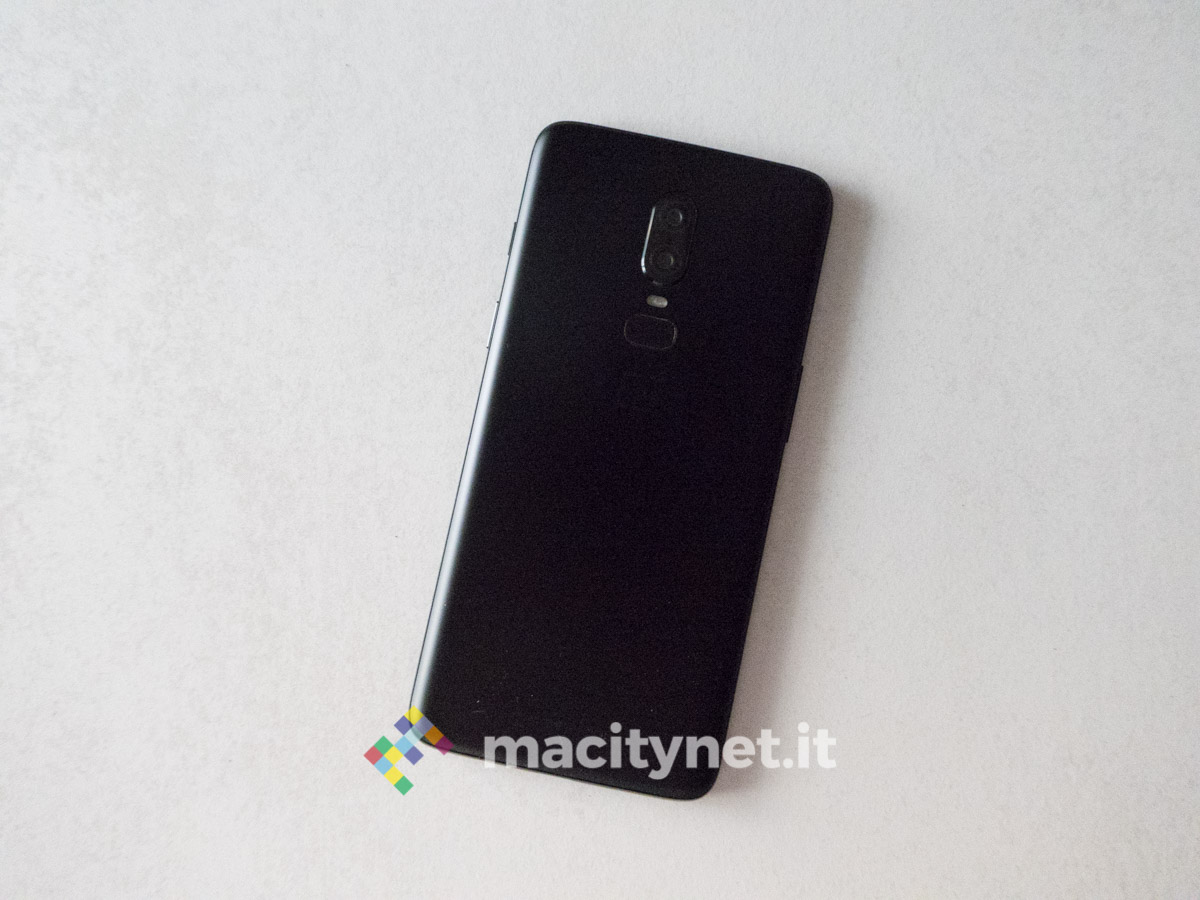
Android, far away yes but not unknown
Our work here on Cyber Layman is intuitively focused on the iPhone world, but it is equally obvious that it is certainly not unknown to us. In fact we talk about it almost every day, without forgetting that over the years, even the writer, has had to deal with sporadic tests of medium-low-end Android smartphones and tablets, thus being able to follow the evolution of the operating system of the green robot parallel to our actual digital life on iOS and macOS.
Switch from iPhone to Android, and vice versa
Switching from iPhone to Android or the other way around, from Android to iPhone, is a fairly common practice and the reasons are the most varied. There are those who do it simply out of curiosity, some out of desire to change with something completely new, some for economic availability or on the contrary to save money, some because they are not comfortable with the operating system and so on.
Between the two, switching from iPhone to Android is currently the most common practice: Kantar statistics show a drop in iOS share in the main European markets in the last quarter of 2017.
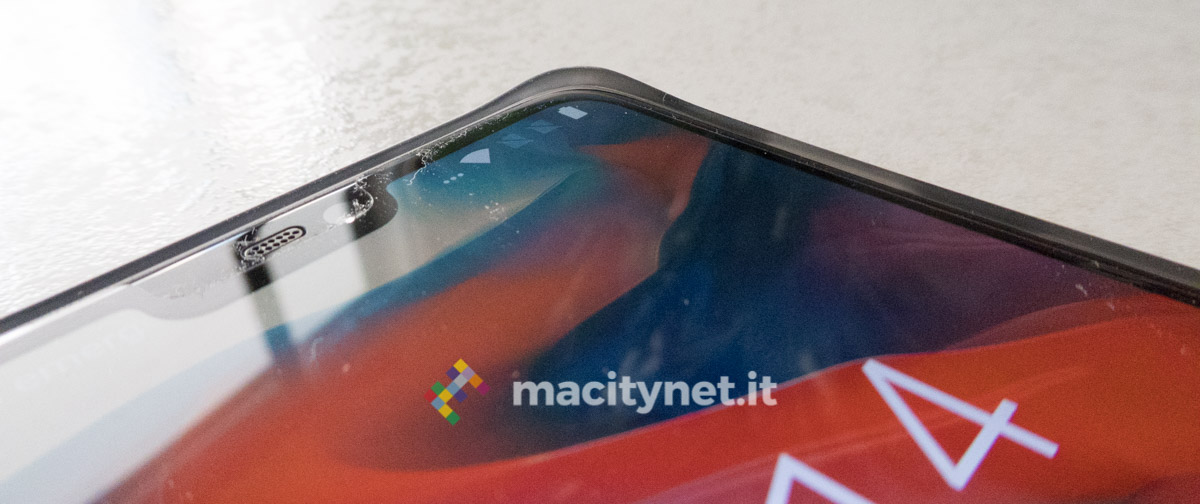
Why OnePlus 6
With iPhone, it's easy to choose. If there is economic availability, we aim for the latest model released, being careful about the memory cut to avoid having to work only with a few apps and sip the space for photos and videos. To save something you can focus on a previous generation model, take advantage of the offers on Ebay or go directly to the second-hand market (with all the associated risks).
For Android, however, the situation is different. There is much more choice, the market is large and varied and ranging from the super-cheap model from 50-100 euros up to the top of the range whose prices do not differ much from those of the Apple counterpart.
So, being able to choose, we said to ourselves: if we had to buy one, which one would we buy? Reiterating that the answer to this question is and remains subjective, we have considered our past tests, mainly focusing on low-end models. They are excellent solutions, but with sometimes limited capacities for our daily use. Furthermore, an evaluation based on the concept of having a secondary telephone was not going to be done, but the main one. Thus, we have discarded the low end of the market (50-200 euros).
At the same time we looked for our test not to an 800 euro phone, because it is too close in cost to an iPhone. Those who make a choice of this type, perhaps buying a Samsung Galaxy S9 or a Note 8, to name two top of the range, in our opinion have reasons that are not easily scratched and in any case, often (net of the offers of the operators) far from the will to save money. Rather, we wanted to understand whether switching from iPhone to Android by choosing a phone that would allow substantial savings and at the same time offer a high quality in terms of components and functions was a viable hypothesis. From this point of view, a model whose cost was around 300-600 euros, of the latest generation as regards integrated technologies and with an excellent quality / price ratio, is ideal.
OnePlus 6 was reviewed on our site some time ago. The gist of that test, which has technical aspects that we will not address, is that the price and quality ratio is the real winning tool with which OnePlus challenges the big competitors. The price (569 euros for the 128 GB version we have chosen, but at the moment you buy on offer with a code: more info at the bottom of the article) is about half of what you can spend for an iPhone X of the same capacity ( in reality, 128 GB does not exist but the 256 GB version costs 1,359 euros) for a high-level product, of recent generation (it was released on May 22) and which compares well to the best iPhone of the moment between Face Unlock, OLED screen frameless and high processing power.
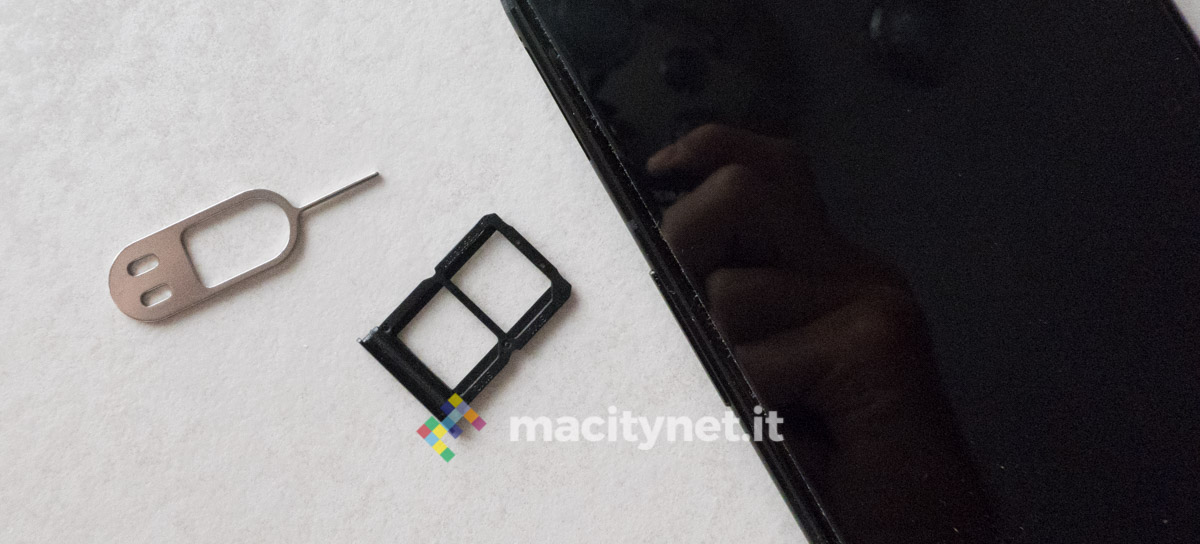
Ready? Let's go!
Switching from iPhone to Android is a matter of seconds. If Apple has its Move to iOS, Google has also developed a system that greatly facilitates the process. Just follow the instructions on the site: time 15 minutes and the new smartphone is ready to use.
In this way, all the data are transferred, that is, not only the address book but also the photos, calendar events, notes, etc. However, the writer has been using Google services for a long time, so in this sense the transition from one platform to another was practically painless: just logging in with the Google account was enough to make everything already in its place.
We install the apps
Our use of the smartphone is the basic one, as well as the functions we use daily. Therefore few, indeed very few, the apps installed: Clock, Calculator and Voice Recorder are already there, so we added Stocard (for loyalty cards), Google Maps for GPS navigation in the car, Dropbox and Google Drive for files on the cloud, Google Translate (you never know), YouTube, Feedly to stay up to date, Super TV Guide to know what it does on TV after dinner, Pinterest, Amazon Music for streaming music, Wunderlist for the collaborative shopping list.
Then, in addition to the Camera and the Photo Gallery (already pre-installed) the three most used apps of all: Telegram for messaging, Gmail and Google Chrome. In reality, we also installed other secondary applications (Adobe Acrobat Reader for scanning documents, Google Calendar, File Manager, Fire TV, IKEA, Goodreads, IMDb for cinema, Instapaper, the bank app and Google Keep for notes. ), but one of the first advantages of Android is to be able to separate the list of all the apps from those used most.
So, instead of having to hide the secondary apps in one or more folders, we have placed only the apps used daily on the main screen while everything else is shown in the list of all applications. OnePlus 6 then offers a “hidden” list (just a swipe to the right in the list of all the apps) to hide from view all those apps that we don't even want to see, such as some unused system apps or apps that maybe we only use via Widgets and that we do not want to see in the list.
Here, the Widgets. On Android, the philosophy is completely different. Here the Widgets can also occupy the whole screen, they are much more dynamic and if desired they can update the contents even every few minutes. Here too we have sipped the use, reducing it to just Notes to make a note of something on the fly, to the Calendar for reminders and events of the day and the meters with the consumption of minutes, SMS and GB of our telephone operator.
The first days: nothing but trauma
We feared that the early days were the worst with all the hustle and bustle that would come with new interface, new applications, new digital life philosophy and an alleged backwardness of the entire system. We remembered the Android screens from a few years ago, which we looked at with contempt from our friends' smartphones, but we soon realized that this is really the past … The difference with iOS is less perceptible than it might seem.
The apps are the same as we find on the iPhone: same developer, same interface. There really is little to complain about here. At least the most common ones or in any case those used by us previously are all there, so from this point of view no regrets.
The Notification Center and the Control Center of the iPhone are gathered here in a single tab. Then a single gesture from top to bottom to call up Notifications and view 6 of your favorite shortcuts right away (for us: WiFi, Airplane Mode, Bluetooth, Flashlight, Rotation Lock and Energy Saving). A second swipe downwards expands the card to show two more (Geolocation and Do Not Disturb) and allow you to scroll through the secondary pages where we find other shortcuts, including Night Mode, Reading Mode, Wireless Transmission, Invert colors, Hotspot, NFC, OTG, Data Saver, Mobile Data, Game Mode, VPN, etc.
To clear up notifications in one go? Just click on the appropriate button, while to delete them individually, simply slide your finger to the left or right above the notification. Simple and intuitive.
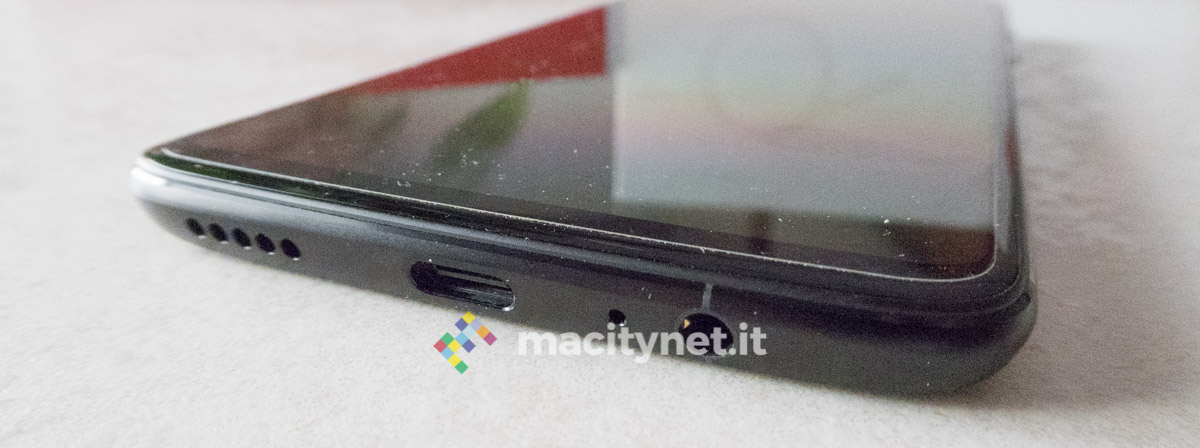
OnePlus 6 and iPhone, not so different
One feature of OnePlus 6 that reduces the gap with iPhone is in the USB-C socket, which in fact guarantees the same reversibility as the Lightning connector. Here, however, there is also the headphone jack, a welcome gift for those who have never digested the idea of using an adapter with, above all, the consequent impossibility of recharging the device while listening to music with headphones. flush.
On OnePlus 6 there is also a three-click switch to quickly switch from Ringtone to Vibration mode and then back to Silent. Also here the same speech a little while ago: it does not make you feel the lack of the Mute button of the iPhone, so the approach to use is immediately natural for those arriving from the Apple smartphone.
Moving on to the news there is the unlock with the face, similar to the Face ID of the iPhone X, but in the comparison it results but less effective and safe. In fact, here the unlocking takes place even with closed eyes and with the face oriented 45 degrees to one side (eye to the wife: goodbye privacy if we sleep), while struggling in the dark (if the brightness of the screen is too low) or with sunglasses covering a good portion of the face. From this point of view, iPhone is ahead and not a little, (but it is a known aspect).
What if we wanted to use the fingerprint sensor? Compared to the iPhone X here there is, but we find it on the back, a position that, it will be for habit, it seemed much less comfortable than the Home button of the iPhone.

Photo, Video and Audio
Moving on to daily use, the dual rear camera is good but not exceptional. In the “point and shoot” photos we have not heard big differences with the iPhone. The colors are in some cases a little too saturated while in the Portrait mode the blur works well with faces while it must necessarily be improved with objects. Superlative slow motion at 460 fps, shots with the front camera acceptable.
The audio in the headphones is very good (of course it depends on the headphones we use and mind you, with OnePlus 6 there are no headphones supplied: praise to Apple that still gives the EarPods) while that of the speaker as regards the volume does not it seemed very powerful. On recent generation Apple phones, there are two speakers for a stereo effect, which is a must to keep in mind if you want to use the phone as an occasional speaker for music.

Display and Notch
Loved and hated, the notch (the notch, or whatever you want to call it, that “puts the horns” on the display to make room for the sensors used by Face ID in the facial unlocking) of the iPhone X was also the most copied by the competition and we find it again also here in OnePlus 6, but with one substantial difference: it can be disguised.
In fact, there is an option within the Settings that allows you to hide the notch area via software, i.e. by creating a black status bar and consequently adapting the user interface and applications within a slightly larger area. narrow (great for videos as some of them won't be as hidden below the notch).
Apple will hardly offer a similar function because it would also mean admitting that it has created a device in a certain sense “limited”, but it is a shame because having the possibility to choose – as happens here on OnePlus 6 – would allow to satisfy both sides.
As for the display, we are faced with a large 6.28 '' AMOLED screen. A feast for the eyes so much to do with the tablet (8 '') that we use at home for some specific tasks as an alternative to the Mac. The maximum brightness is among the highest we have ever seen, outdoors it is very bright and clearly visible. The colors are well calibrated and there is the possibility to change them manually by choosing some of the ready-made profiles – sRGB, DCI-P3 – or with the adaptive mode that constantly calibrates them based on the ambient light or by manually setting the hue.
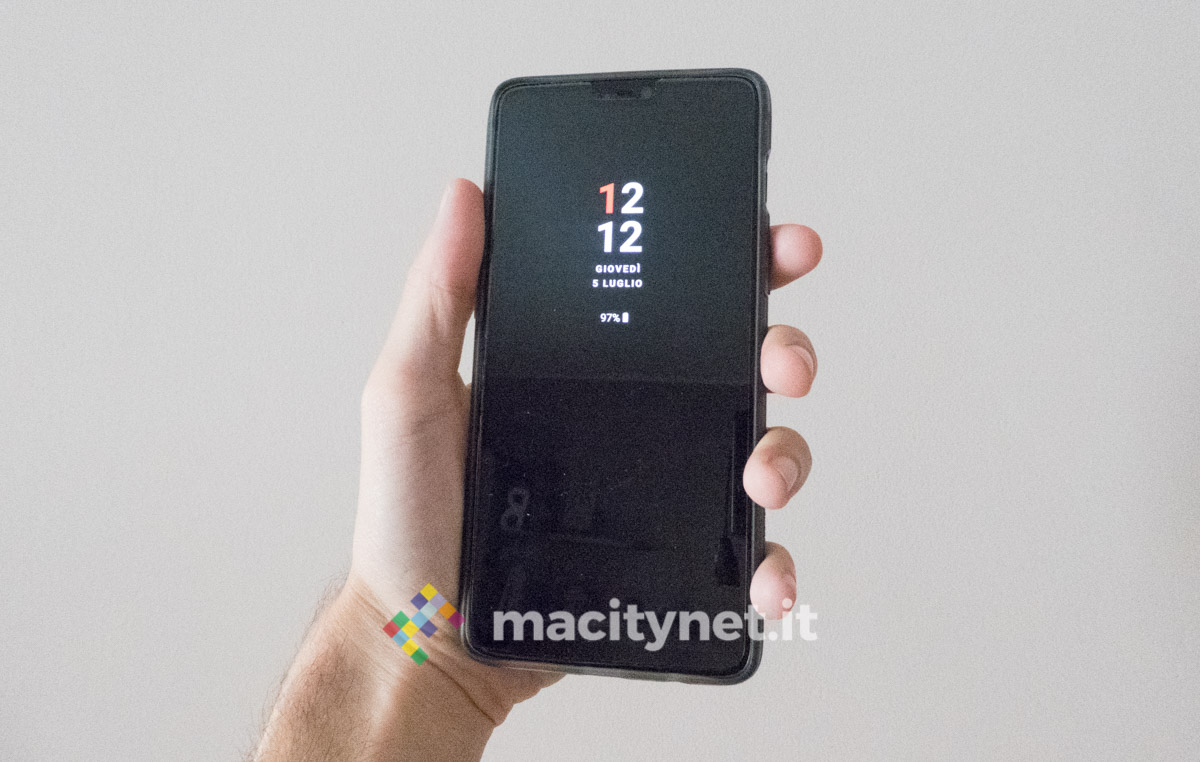
Software and gestures
OnePlus 6 approaches iPhone X also in terms of gestures. It is in fact possible to eliminate the keys on the display in favor of actions that resemble those adopted by Apple in its latest smartphone. A swipe from the bottom edge upwards by placing the finger in the center of the screen closes the app in use, stopping the finger halfway (in the center of the screen) Multitasking is started. Swiping your finger upwards from one of the two corners instead takes you back.
Then there is the possibility of hiding the content of the notifications upon receipt, a function recently introduced by Apple and which denies the reading of the messages received to those in the vicinity of the smartphone left momentarily unattended.
Final impressions
Summing up is not difficult because, as we have already repeated several times, it is a completely subjective judgment. Ultimately, the problem we had in our heads cannot be said to have melted, but it has mitigated. At the end of the test, perhaps the best way to deal with the problem is to admit that it makes little sense to make comparisons between iOS and Android, even when talking about a product like OnePlus 6 which, for hardware functions (the Mute switch, the USB-C port , facial recognition) and software improvements (the iPhone X-style gestures, the excellent fusion of Notification Center and Control Center), is perhaps among the Android smartphones less distant from the user experience offered by Apple with iPhone.
Both operating systems have strengths and weaknesses but what we lacked could be an advantage for someone else (and vice versa).
If we had to do a quick summary, we would say that we liked:
Conversely, we did not like and / or we felt the lack of:
Conclusions
But so if you decide to migrate from iPhone to an Android phone like OnePlus 6, should you buy it or not? If you've read this far, you actually already know the answer. For those who jumped to conclusions immediately, the answer is “Ni”. If you want to switch from iPhone to Android for whatever reason, then perhaps this is one of the best smartphones to save money by having a good quality product.
The price is favorable compared to the functions and the constructive care, moreover the user interface, as well as some hardware gems, make the change almost painless. These considerations, we specify, are especially valid if you have an iPhone from a few generations ago that you like tightly and you no longer want to unpick 800 or 1000 euros for a smartphone. In our opinion it makes sense to rely on OnePlus 6 or in general on a top of the Android range only if you are driven by the need to change, and it makes sense to do so only when there is a real difference in price, as happens for OnePlus 6.
If you ever recognize yourself in this profile, OnePlus 6 is found in many eCommerce sites, choose the best one by evaluating on the basis of price and reliability. As mentioned, ours was offered to us by GearBest: at the moment the model with 6GB of RAM and 64GB of capacity is on the flash offer at 430 euros but by entering the code IT $ MPOP64 you pay 413 euros . The most performing version – 8 GB of RAM, 128 GB of capacity, the same tested by our editorial staff – costs 530 euros but with the current offer it is sufficient to enter the code GB $ MPoneplus128 to pay 485 euros.
,,





